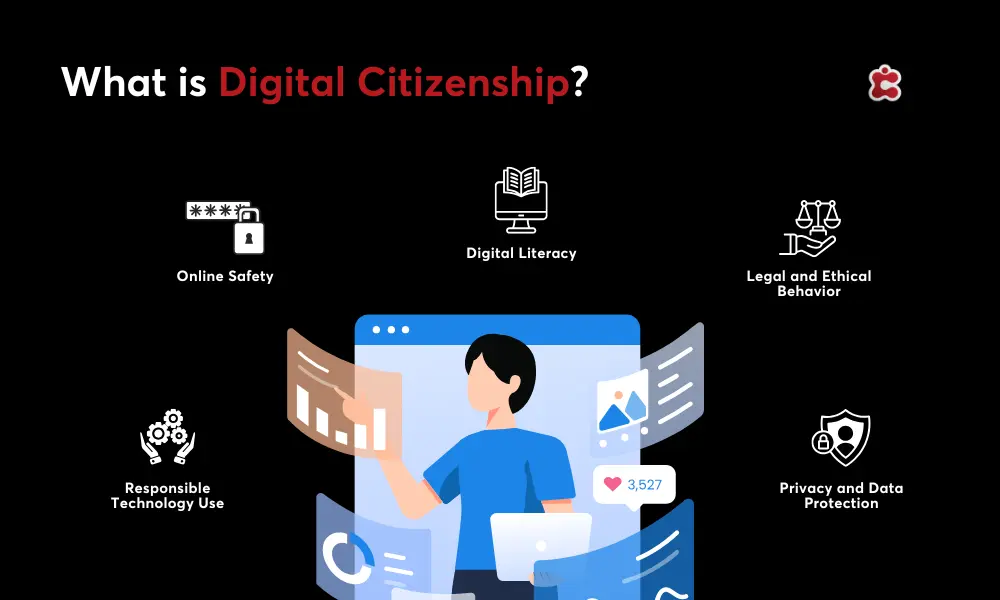Today’s students are the first generation to grow up in a fully digital world. From social media to online classrooms, their daily lives revolve around technology. While this opens up exciting opportunities, it also comes with challenges. How can we ensure they navigate the digital world responsibly, respectfully, and safely?
Now schools have a new responsibility. Helping students become digital citizens is no longer optional—it’s a must. Think of digital citizenship as teaching students the “rules of the road” for the online world.
But don’t worry, schools don’t have to figure this out on their own. Your Student Information Systems (SIS) can help. Sure, they’re great for managing schedules and grades, but they can also be powerful tools for teaching digital citizenship. We’ll show what digital citizenship really means, explore how SIS can make it easier for schools to promote it, and share practical tips to help students thrive in our digital world.

What Are Digital Citizens?
Digital citizenship is all about using technology responsibly, ethically, and effectively. It’s the set of skills and values students need to navigate the online world in a way that’s safe, respectful, and productive.
Digital citizenship has a few key components. First, there’s online safety, which includes knowing how to protect personal information and recognizing potential risks like phishing or scams. Then, there’s digital literacy—understanding how to critically evaluate information, spot fake news, and use digital tools effectively. Ethical behavior is another cornerstone, teaching students to communicate respectfully, avoid plagiarism, and think about the long-term impact of their online actions. And, of course, there’s cyberbullying prevention—an essential aspect of creating positive online environments.
So, why does this matter so much for K12 students? Because the digital world is now a big part of their lives. This extends to scrolling through social media, collaborating on school projects, or preparing for future careers. Developing strong digital citizenship skills helps students stay safe online and prepares them to contribute meaningfully in an increasingly connected world.
SIS in Shaping Digital Citizens
Student Information Systems are more than just data management tools—they’re powerful allies in shaping responsible, future-ready digital citizens. Let’s dive into how SIS features can make a real difference.
Promoting Digital Literacy
SIS platforms often integrate e-learning tools that make digital literacy an everyday part of education. With access to multimedia resources, online libraries, and interactive lessons, students can develop critical skills like researching, evaluating information, and using technology effectively.
Encouraging Responsible Online Behavior
SIS tools like behavior tracking and communication modules help schools guide students toward respectful and ethical online interactions. Features for monitoring and addressing cyberbullying ensure that harmful behavior is identified and managed quickly.
Collaboration and Engagement
Collaboration is the foundation of digital citizenship, and SIS platforms make it easy with discussion boards, project tools, and peer feedback features. Students learn how to work together effectively, share ideas, and respect diverse perspectives—all essential skills for thriving in today’s connected world.
Monitoring and Ensuring Online Safety
Parental controls, usage monitoring, and activity reports within an SIS help schools and families ensure students stay safe online. These tools give educators and parents peace of mind while encouraging students to explore the digital world responsibly.
Essential SIS Features That Shape Digital Citizens
| Feature | How It Shapes Digital Citizens |
| Communication Tools | Real-time messaging and announcements help students, teachers, and parents stay connected, promoting respectful online interactions. |
| Behavior Tracking | By monitoring online behavior, schools can identify areas where students need guidance, encouraging responsible use of technology. |
| E-learning Integration | Access to online courses, digital resources, and multimedia tools supports digital literacy and empowers students to learn at their own pace. |
| Parent and Teacher Portals | These portals enhance collaboration between school staff and families, ensuring a unified approach to teaching students digital responsibility. |
| Data Security and Privacy Controls | Protecting students’ data is vital. SIS platforms like Classter provide strong security measures to ensure a safe digital environment for all users. |
Practical Ways Schools Can Use Their SIS to Shape Digital Citizens
1. Implementing Digital Citizenship Lessons
Teaching digital literacy and ethics is crucial, and your SIS can help you organize it seamlessly. Use the platform to schedule workshops or courses on topics like online safety, responsible social media use, or evaluating online information. With automated reminders and attendance tracking, schools can ensure these lessons are accessible and engaging for students.
2. Monitoring Student Progress in Digital Skills
Digital skills are just like any other—students grow with practice and guidance. An SIS allows educators to track how students engage with e-learning platforms, collaboration tools, and other digital resources. By measuring growth in areas like research skills, online communication, or media literacy, teachers can provide targeted support to help students excel.
3. Encouraging Parental Involvement
Parents play a key role in shaping digital citizens, and your SIS can bridge the gap between school and home. Through a parent portal, schools can share helpful resources like guides on managing screen time or starting conversations about online behavior. You can also use it to keep parents informed about workshops or school initiatives focused on digital citizenship.
Tips to Maximize SIS for Digital Citizenship
Tip 1
Use the SIS communication features to model good digital behavior by setting guidelines for discussions. These tools are perfect for teaching students how to navigate online conversations with empathy and respect.
Tip 2
Who doesn’t love a little friendly competition? Many SIS platforms come with gamification elements like badges or leaderboards. You can use these features to reward students for completing digital citizenship activities, like practicing online safety tips or contributing to group projects.
Tip 3
Your SIS is packed with data that can help you spot trends and gaps in digital skills. Regularly review reports on student engagement, participation in digital activities, or behavior tracking. These insights allow educators to tailor their approach, offering extra guidance where needed.
Classter Helps Create Digital Citizens
When it comes to shaping the next generation of digital citizens, Classter’s Student Information System stands out as the ultimate all-in-one solution for K12 schools. Designed with modern education in mind, Classter offers an integrated platform that supports every aspect of digital citizenship.
With features like communication tools, schools can promote respectful online interactions while keeping parents, teachers, and students connected. Classter’s behavior tracking system ensures schools can monitor and guide students toward positive digital habits, addressing issues like cyberbullying head-on. The gamification elements motivate students to engage in lessons on digital literacy, while the parent portal bridges the gap between school and home.
What sets Classter apart is its ability to centralize these functionalities into one seamless platform. Ready to transform your school’s approach to digital citizenship? Let’s build the digital leaders of tomorrow, together!
FAQ’s
Digital citizenship refers to using technology responsibly, ethically, and safely. It encompasses key areas like online safety, digital literacy, ethical behavior, and cyberbullying prevention, ensuring students can thrive in the digital world.
An SIS like Classter can help schools integrate digital citizenship lessons, track student progress in digital skills, and ensure online safety. With features like behavior tracking, e-learning integration, and communication tools, schools can actively guide students in developing responsible digital behaviors.
Classter’s SIS offers features such as communication tools, behavior tracking, and e-learning integration, which help schools teach students about online safety, respect, and responsible technology use, while also involving parents in the process

